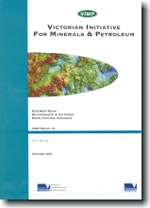VIMP Report 78 - Basement-Basin Relationships in the Otway Basin, Victoria, Australia
 |
| |||||||||||||||
Product description:Download The downloadable version of this report is supplied in PDF format. Abstract This report gives the results of an integrated study of the potential field, bathymetric and seismic data and examines the linkages between the Otway Basin and its basement. It suggests possible correlations between the hydrocarbon accumulations and the basement. In order to test the validity of the potential field method, the report also compares the interpretation of the potential field data with a pre-existing seismic interpretation over the Torquay Sub-Basin. At the regional scale, the Otway Basin is part of the larger east-west rift system that extends across the southern margin of mainland Australia. In South Australia and Western Australia this system has east-west-trending antecedents that go back to the Neoproterozoic. In Victoria and easternmost South Australia, the basement on which the Otway Basin lies can broadly be divided into three tectono-stratigraphic provinces. In the west, the basement is the Delamerian Fold Belt, which was cratonised in the Middle to Late Cambrian. North from the Bambra Fault and east from the Moyston Fault, the basement to the eastern Otway Basin is the Lachlan Fold Belt. This was progressively cratonised between the Late Ordovician and the Middle Devonian. Southeast of the Bambra Fault, the basement is the Selwyn Block, the northern extension of Tasmania into Victoria (VandenBerg et al. 2000). This was finally cratonised in the Cambrian but includes parts that were cratonised in the Neoproterozoic. The three different basement types influenced the early basin formation:
West of the Merino High, the basement rocks are the Kanmantoo Group. These Cambrian metaturbidites, carbonates and rift volcanic rocks have a high ductility contrast. Their northwest-trending fold axes and faults are reflected in the arcuate shapes of the rift faults in and around the Penola Trough. The Katnook-Hazelgrove gas fields lie above a distinct arcuate gravity high that cuts across the dominant rift direction. Above the rifted basement, facies variations in bores in the Eumeralla Formation seem to be controlled by basement highs that can be seen on Bouguer gravity images. Gravity highs correlate with more alluvial facies, while gravity lows correlate with more lacustrine facies. If this correlation holds elsewhere, it would provide a means of identifying areas with favourable source rocks. The Bouguer gravity data also shows another prominent graben system that follows the upper edge of the present-day continental break of slope. This graben system has been recognised on some previous interpretations, but the gravity data seem to indicate that it is perhaps 250 km long and about 20 km wide. Within this it is strongly compartmentalised, with most compartments tending to thicken away from the continent. Correlation with seismic interpretations indicates that it probably formed either late in the Early Cretaceous or early in the Late Cretaceous. A third graben system seems to be present in the midslope regions of the continental edge, typically at about 3 km water depth. The sparse data available implies that it too may be quite extensive. Interpretations of the few seismic lines across it suggest it is probably early Late Cretaceous, filled with Sherbrook Group sediments. Bibliographic reference Moore, D.H., 2002. Basement-Basin Relationships in the Otway Basin, Victoria, Australia. Victorian Initiative for Minerals and Petroleum Report 78. Department of Natural Resources and Environment. Related products:
| ||||||||||||||||


